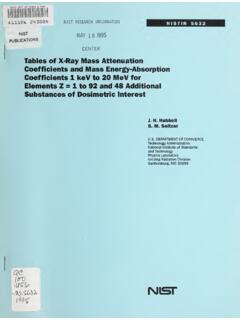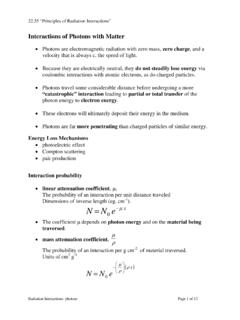Transcription of Shielding Equations and Buildup Factors Explained
1 Shielding Equations and Buildup Factors Explained Gamma Exposure Fluence Rate Equations For an explanation of the fluence rate Equations used in the unshielded and shielded calculations, visit this US Health Physics Society webpage: It is a very good white paper by George Chabot, CHP, PHD that takes you from electric charge produced in the air by the photons to a usable equation and also explains where the simplified rule of thumb R/hr = 6 CEN equation comes from. Linear attenuation Shielding Formula: xABeII =* Where: =BI the shielded dose rate =AI the initial dose rate = the linear attenuation coefficient in cm x = the shield thickness in cm The linear attenuation coefficient can be considered as the fraction of photons that interact with the Shielding medium per centimeter of Shielding .
2 This coefficient assumes that all photons that interact are removed and ignores Compton scatter and pair production photons (underestimates the shielded dose rate and the Shielding required). It is also known as narrow beam conditions because the source and detector are assumed to be collimated and the measurement made at a short distance. Source in shielded shield plug removed(collimated source)Detector with side shield collarDetector end only exposed(collimated detector)No photons are scattered. The only way to make this happen is to side and back shield the source and the detector (collimate). This only applies at close distances though. Further away, the air scatters the photons in real life. This is idealistic and without the collimation or at a longer distance, the dose-rate is underestimatedNarrow Beam ConditionsShield Linear Energy Absorption Shielding Formula: xABeneII =* Where: =BI the shielded dose rate =AI the initial dose rate =en the linear energy absorption attenuation coefficient in cm x = the shield thickness in cm The linear energy absorption attenuation coefficient can be considered the fraction of energy removed from the photons by the Shielding medium per centimeter of Shielding or the fraction of energy absorbed.
3 This coefficient takes into account Compton scatter and pair production photons but it assumes that all scattered photons reach the detector (overestimates the shielded dose rate and the Shielding required). It is also known as broad beam conditions because the source and detector are assumed to be uncollimated. Unshielded sourceUnshielded detectorScattered electromagnetic energy included(but all scattered photons are assumed to reach the detector)This is unrealistic and overestimates the shielded Beam ConditionsShield FAQ: What is a Buildup Factor? Unshielded sourceUnshielded detectorScattered electromagnetic energy included(but only some of the scattered photons reach the detector)ShieldUsing Buildup (closer to real life) Many of the people who use my software are not radiation protection or health physics professionals.
4 Some are students and some are engineers of other disciplines who find themselves in a position to occasionally perform Shielding Equations , designers of thickness gauges and other test equipment that utilize radioactive sources. I was getting this question so often, it prompted me to write this paper. Since using the attenuation coefficient (method 1) underestimates the dose-rate on the other side of the shield and using the energy absorption coefficient (method 2) overestimates it, a method of getting closer to the real-world dose-rate was needed. A Buildup factor is a correction factor to multiply the number obtained from using the attenuation coefficient by that hopefully gives us the correct answer, a number in between method 1 and method 2 results.
5 Some may call it a fudge factor. Through the years, teams of professionals worked together to come up with tables of Buildup Factors for Shielding calculations. Tables of many Buildup Factors are required because the factor varies with gamma energy, shield material and with shield thickness. The most recently accepted tables come from the American Nuclear Society (ANS) and the American National Standards Institute (ANSI), published in 1991. New work has been done on Buildup Factors since then. In 1991, the numbers indicate that at low energies the Buildup factor is 1 or close to it. New studies and new calculations indicate that it is not so. A paper published in 2001, Low and High energy Factors for selected materials updated with Monte Carlo code Factors : Chibani, Omar, 2000.
6 "New Photon Exposure Buildup Factors ", Nuclear Science and Engineering, Volume 137, 2001 has supplemental numbers to the ANS/ANSI tables at low and high energies and explains the physics and reasons behind the new numbers. Work on new Buildup Factors has slowed in recent years, probably due to the release of new Monte Carlo based codes which seem to be giving a higher level of accuracy than Buildup Factors . These codes are expensive and have a steep learning curve so the 1991 tables, along with the Omar Chibani numbers are still useful, especially when a high degree of accuracy is not required. If one is designing a nuclear reactor dome, having a highly accurate number could save hundreds of yards of concrete and time to pour it.
7 Monte Carlo code is a must then. If one has a small source to ship and needs to calculate a pig thickness, the difference between 5 or 6 centimeters of lead may not matter. Linear attenuation Shielding Formula With Buildup : xABebII =** Where: =BI the shielded dose rate =AI the initial dose rate b = the Buildup factor for one energy at the shield thickness x = the linear attenuation coefficient in cm x = the shield thickness in cm This formula attempts to estimate the correct number of scattered photons that reach the detector (closest estimate) by using a correction factor to add in the Compton scatter and pair production photons that are ignored by the linear attenuation coefficient formula. Linear attenuation Shielding Formula With Buildup for Multiple Photon Energies: )**.
8 **(*321332211xiixxxABiefbefbefbefbII +++= Where: =BI the shielded dose rate =AI the initial dose rate bi = the Buildup factor for each energy (up to the ith energy) at the shield thickness x =i the linear attenuation coefficient for each energy (up to the ith energy) in cm fi = the fraction of IA that comes from each photon energy (e in MeV) = iiiiinene** ni = the yield or probability of emission factor for each atomic decay for each energy x = the shield thickness in cm This formula attempts to estimate the correct number of scattered photons that reach the detector (closest estimate) for each energy by using correction Factors to add in the Compton scatter and pair production photons that are ignored by the linear attenuation coefficient formula.)
9 attenuation and energy absorption coefficients can be found on line at: and The numbers in the table are mass attenuation coefficients and the mass energy absorption coefficients or / in cm2/g. These represent the fraction of photons removed and the energy removed respectively per unit density of material. You have to multiply the table Factors by density in g/cm3 to get the linear factor equivalents in cm. Buildup Factors are obtained from tables available for a cost from the American Nuclear Society. They are not available online anywhere that we could find. You have to calculate the number of relaxation lengths, R or mean free paths (mfp) to use the table. x = 1 relaxation length or 1 mean free path (MFP) = ln(IB/IA) Where is the linear attenuation coefficient and x is the shield thickness Your energy will end up in between two numbers as will your number of relaxation lengths.
10 You will have to do a 4 way interpolation between the four values that you obtain from that table. For Co-60, you have two energies, so you will have to do the four way interpolation twice, once for each energy. Each energy will have its own MFP value because each has its own value. With isotopes that have multiple energies (Ra-226 with daughters has well over 26 energies) it gets complicated and the math by hand or even with a spreadsheet would be intense. That is why we developed computer code to do all of that work for you. On the last page is a typical Buildup factor table for tungsten. Ray McGinnis, MIT Rad Pro Calculator Software Development Energy MeVR(mfp) +00 + + +04 + + +06 +05 +05 +04 +03 +01 +00 +00 +00 + + +07 +07 +06 +05 + +00 + + +09 +08 +08 +06 +04 +02 +00 +00 +00 + +03 + +11 +10 +09 +07 +05 + +00 + +03 + +12 +11 +11 +09 +06 +04 +01 + +03 +04 + +14 +13 +13 +11 +08 710080 +15 +14 +13 +11 +09 192476 1469080 +15 +14 +14 +12 +09 126291 986876 7541080 + + +46 +46 +46 1E+47 +47 2E+47 3E+47 +62 +61 +60 +58 +56 +53 +50 2E+47 2E+47 4E+47 4E+47 1E+48 +48 +48 +48 +49 +49 5E+49 +49 +50 +50 +50 +51 +52 +53 +54






